Pepper Cumin Rasam is a soup; it is not a stew or a drink. Rasam is from South India and there are dozens of versions of it made with different ingredients. It can be served as an appetizer, as a part of the main course mixed with rice or can be consumed as a post meal digestive. The spices and herbs used in rasam can be consumed as a soup or the broth itself be strained and consumed. There is a versatility to rasam that I have not seen in other soups, especially in terms of its composition and its application.
In fact, rasam is a distinctly South Indian dish. It is ‘Rasam’ in Tamil Nadu and Kerala, ‘Tili Saaru’ in Karnataka, and ‘Chaaru’ in Andhra. It is a comfort food, and virtually every household has its own variation of this delicious yet spicy soup. The recipe below is my own Pepper Cumin Rasam which is a variation of the the lemon and pepper rasam.
Pepper Cumin Rasam:
What makes this rasam unique is that it is made with three types of pepper: cubeb peppercorn, long peppercorns, and black peppercorns. Peppercorns have long boasted many health benefits, from being rich in antioxidants, to promoting gut health, and lowering cholesterol. Additionally, cumin also has many health benefits, from helping improve digestion, to anti-inflammatory properties and boosting memory.
At lunch, Indian households typically have rice with a special gravy to begin with, and then have a generous drink or addition to their rice with rasam, and finally end their meals with yogurt. Of course, there are side dishes and desserts. While rasam has many variations, it has of course a common root. To commonly qualify as a ‘Rasam’ some of the following ingredients should be used: curry leaves, tamarind, garlic, tomatoes, some kind of lentils, and of course, water.
There are different types of rasam such as tomato rasam, dhal rasam, lemon rasam, and so on. Here, my Pepper Cumin Rasam recipe is a hybrid of the lemon and pepper rasam. I urge you to experiment and create your own versions of rasam. I have not seen a more versatile soup, and we have only now begun to explore its boundaries. This is especially true as we move into the colder months. Moreover, what I have read about and observed is that rasam is a powerful ward against seasonal colds, a great way of clearing sinuses and keeping your gut healthy.
A word on the unique ingredients:
The image below encompasses the three types of peppercorns that I have used in this recipe.
All peppers have medicinal and health properties, and we are only now beginning to research them. Below is the summary of what I have found to be unique about the peppers I have chosen to use.
- Black peppercorns are left on the vine to fully mature, then are picked and dried in the sun or blanched before drying. Its distinctive ‘biting’ flavor is because of the alkaloid ‘piperine’. Piperine has many pharmacological health benefits, such as the elimination of free radicals and helping to regulate blood sugar levels.
- A cousin of the black peppercorn, long peppers are native to India. They have a hot and sweet flavor and is more pungent than the black pepper and have been used for generations as ayurvedic aid in digestion and stomach-related problems.
- The cubeb pepper is cultivated mainly in Indonesia. They are unique because they have a camphor-like aroma that tempers the piquant flavor of pepper. In Indonesia, they were used to ward off spirits and demons, although today they have a wide range of medicinal uses including being an effective antiseptic and as a remediation for respiratory illnesses.
Summary of an article on the importance of soaking lentils:
We know that certain types of pulses cause gas in the body. Lentils contain phytates and lectins that help in eliminating gas-producing elements in the body. According to the Harvard T.H. Chan School of Public Health, soaking and boiling foods that contain lectins and phytates can neutralize these compounds and potentially reduce digestive problems.
Soaking lentils increases the mineral absorption rate of the body through the activation of an enzyme called phytase. Phytase helps in binding calcium and iron. Soaking also activates a compound called amylase that breaks down complex starch in lentils and makes them easier to digest.
How to soak lentils before cooking:
- Wash the lentils in a bowl by rubbing them with your fingers for at least 3-4 times. You could use a colander and wash with running water from your kitchen faucet.
- Soak the lentils in a bowl filled with water for at least an hour. Whole pulses take longer and need to be soaked for at least 2 hours, while split pulses need about 30 minutes to an hour.
- Soaking will help break down the complex carbohydrates and cut down the cooking time.
Some Common Questions:
1.Can I use tamarind instead of lemon juice?
Tamarind is more commonly used in rasam, although lemon is also a healthy alternative.
2. Is soaking the lentils necessary?
Besides the health benefits of soaking, the lentils get cooked faster if they are pre-soaked, thus saving you time.
3. Would it be possible to reheat rasam again the next day?
Pepper Cumin Rasam will keep in the refrigerator for at least five days. Heat only the amount of rasam that you plan on consuming for that day. If you like healthy drinks, then try my Fennel and Cumin Tisane!
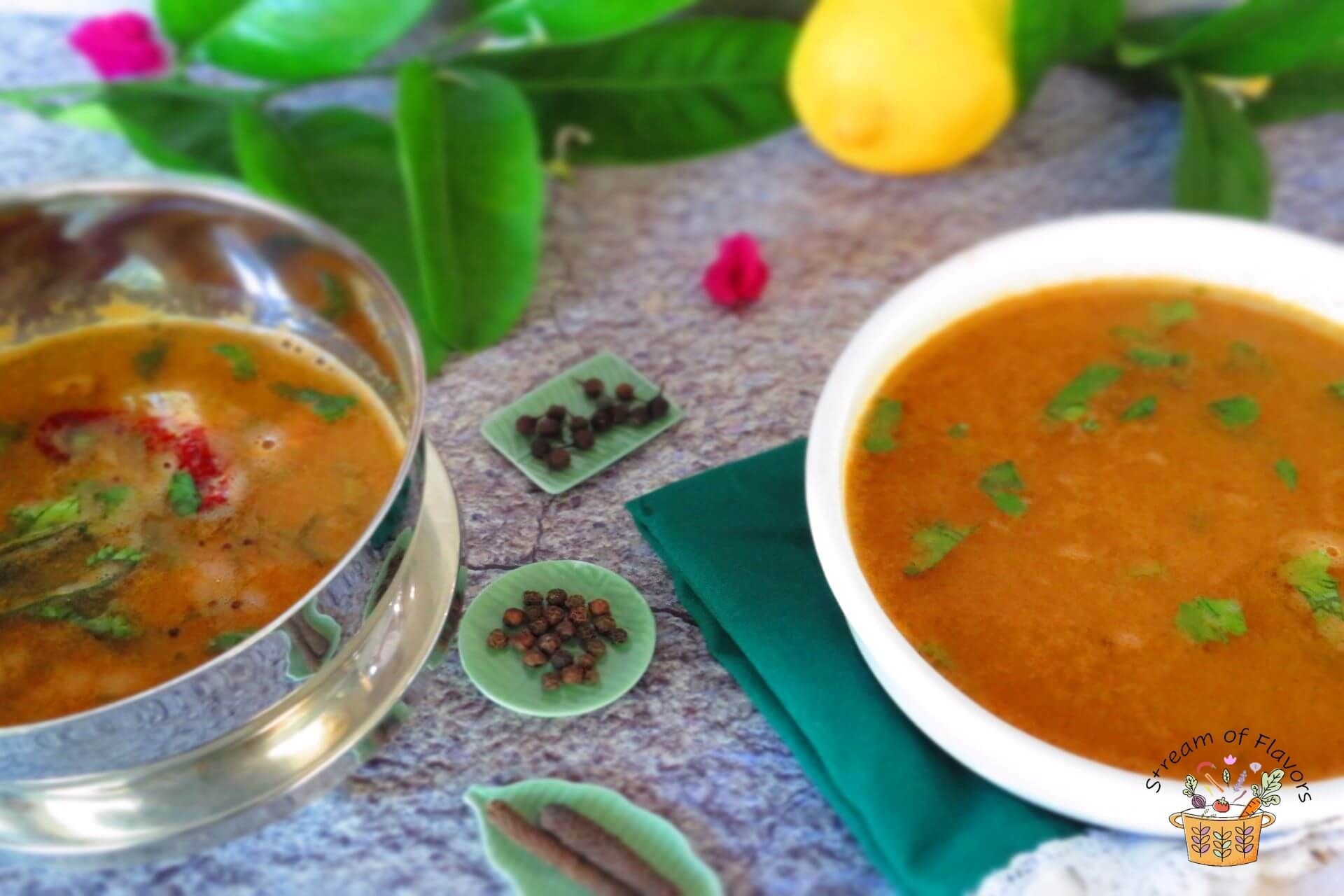
How to make the Pepper Cumin Rasam:
- Prepare the lentils by pre-soaking and cooking them using a pressure cooker or boiling them in hot water.
- Heat a pot, add sesame oil, and season the mustard seeds. After they splutter, sprinkle the hing or asafetida into the oil and toss in the dried red chilis and curry leaves.
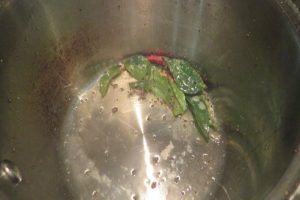
3. Purée the cooked lentils using a hand blender. Add the puréed cooked lentils with the water. Mix in the turmeric powder, salt, and crushed garlic.
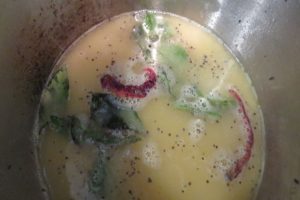
4. Add the puréed tomatoes. Powder the three peppercorns and cumin seeds and add to the rasam.
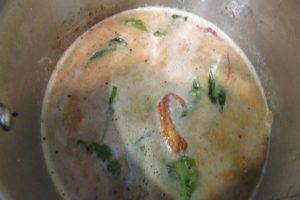
5. Bring to a boil, and then turn off the heat. Add the both the lime and lemon juices. Garnish with chopped cilantro.
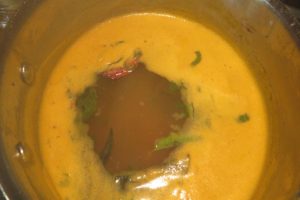
Pepper Cumin Rasam
Equipment
- Stovetop
Ingredients
- ½ cup thor dhal
- ¼ cup masoor dhal
- 2 long pepper
- 1 tsp cubeb pepper
- 1 tbsp black peppercorns
- 1 tbsp cumin seeds
- 12 cherry tomatoes
- ¼ tsp turmeric powder
- 2½ tsp salt
- 4 cloves garlic
- 6 sprigs cilantro
- 1 lemon juice
- ½ lime juice
For the seasoning:
- 1 tsp mustard seeds
- 2 dried red chilis
- 6 curry leaves
- ¼ tsp asafetida
Instructions
- Prepare the lentils by soaking them for 30 minutes. Cook the lentils with the water using a pressure cooker or boil them in hot water.
- Heat a pot, add sesame oil, and season the mustard seeds. After they splutter, sprinkle the hing or asafetida into the oil and toss in the dried red chilis and curry leaves.
- Purée the lentils using a hand blender. Add the puréed lentils with the water. Mix in the turmeric powder, salt, and crushed garlic.
- Add the puréed tomatoes. Powder the three peppercorns and cumin seeds in a coffee grinder or mixie and add to the rasam.
- Bring to a boil, and then turn off the heat. Add the both the lime and lemon juices. Garnish with chopped cilantro.
Notes
- Do not add the lemon juice while the rasam is boiling. Turn off the heat and then add the lemon and lime juices.
- Pulse the lentils well so that they are not grainy. What you want is a smooth soup that is easy to consume and digest.
Nutrition


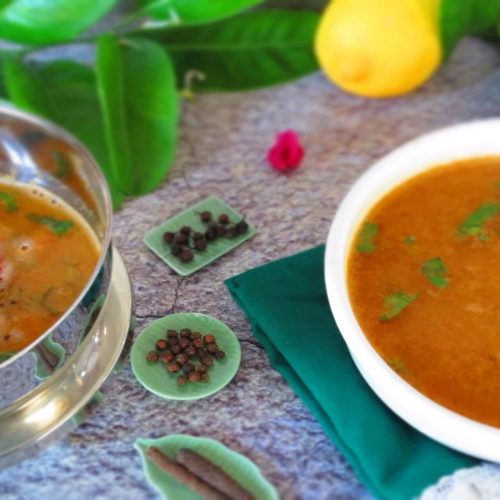




















yummy!